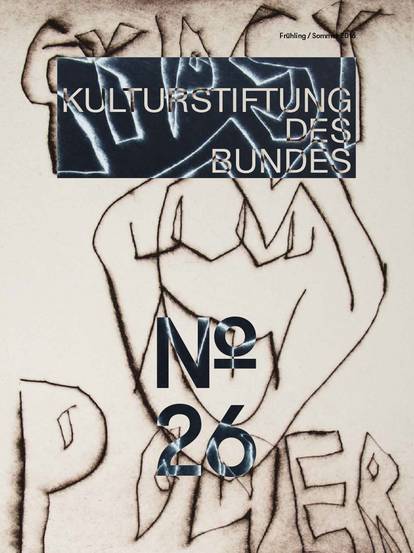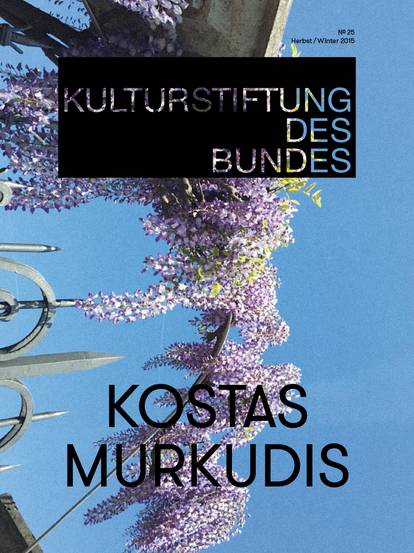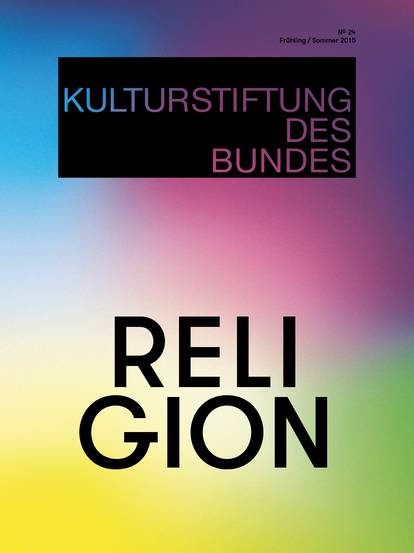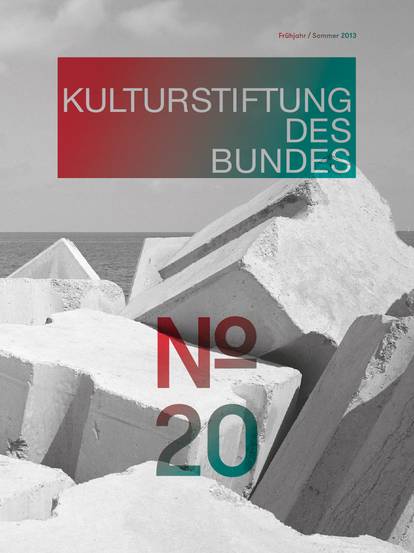Gregor Quack: I would like to start by asking what exactly DIS is. I know that you are a group made up of four individuals: Lauren Boyle, David Toro, Solomon Chase and Marco Roso. But beyond that it seems like the more I read about you, the more different definitions I find.
Lauren Boyle: It's true. We've been called everything from a design collective to a fashion magazine. We’re an art collective, we’re editors, we’re stylists, we’re entrepreneurs, and now we’re curators. We really embrace this multivalence. Whenever anybody has a new name for it, we say 'Bring it on!'
Gregor Quack: Yet there are also interesting distinctions you make between yourselves and other groups. You once explained in an interview that you operate more as an entity than as a collective. What did you mean by that?
Lauren Boyle: When we call ourselves an entity that does signal a certain affinity with business. We have established ourselves as an LLC rather than, say, a non-profit. Of course, the funny thing is that it doesn’t even work that well on a financial level. Originally, we just did it because it was the easiest way to get a bank account with multiple signatures of people that are not married to each other. It all started in 2008, when David and Solomon sent out an e-mail blast to a group of friends about wanting to start an online magazine. Soon the conversation was distilled into a core group of first seven and then four people. We started the magazine website, and soon expanded into our image agency DISimages and a store for artist-designed products called DISown.
Gregor Quack: The fact that to conduct yourself as a business seemed like the logical thing to do also says something about the state of the New York art scene, no?
Lauren Boyle: Exactly. DIS was born in the wake of the financial crisis, which was a really interesting moment to be in New York. We had all been very busy doing all kinds of things in the so-called creative industries, including work for mega corporations like Apple. Because it was freelance, those jobs dried up pretty quickly after the crash. For the first time in years, we found ourselves with a bunch of free time on our hands. We are sensitive to the fact that the crisis was horrible for many people, but for us it was very cathartic and productive.
Gregor Quack: Although the crisis soon developed into a global problem, it must have felt that much more seismic in New York, the home of Wall Street.
Lauren Boyle: Absolutely, it was much more than just an economic turbulence. For us, it felt like a clean break with the decade that had come before. This was the same year that Obama became president. It was a cultural, aesthetic, a mental shift. Everything was put into question. And we saw this as our opportunity to create a platform for all the amazing creative people we knew that didn't have any public visibility at the time.
Gregor Quack: Does your affinity to business also change how you interact with friends and colleagues around you? As an LLC, can there be a meaningful difference between collective thinking, friendship and networking?
Lauren Boyle: Of course networking has added connotations, but we welcome those. When we started the magazine we were expanding our network. The advantage to thinking in terms of a network is that the word itself already suggests a potential for change and growth. You always want to bring a certain amount of new people in for every project, but you also don't want to lose where you came from. So many people have helped us over the course of the past few years so, of course, our Berlin Biennale is going to be full of these people, some old and some new.
Gregor Quack: Seeing as you’re now curating a large biennial, it seems remarkable that the institutional art world played almost no role in the early work of DIS. Does this also have something to do with your backgrounds as New Yorkers?
Lauren Boyle: That is a big part of it. In New York, it's survival. There is almost no public funding for art, the rents are high, there are more crossovers between industries. There is less stigma attached to having a job alongside your art practice. It’s not such a big deal to have an art practice and also work at a tech company. For us it was actually very formative to have these different experiences instead of living in an art-world bubble. Marco is the only one of us who has ever explored being a solo artist, but he was also a creative director in beauty advertising, his clients were Garnier, Wella, and L'Oréal. If we had wanted to be painters, we may have moved to Berlin or Philadelphia, but we all knew we wanted to live in the chaos of New York.
Gregor Quack: If the identity of both DIS and many of its core members is so strongly connected to a city like New York, how does it feel to transition to Berlin?
Lauren Boyle: The move to Berlin allows us to cultivate the feeling of foreignness. We are from another country and another system, and in a sense the institution of KW and the Berlin Biennale feel like foreign countries to us. We don't always speak the same language, but we think this brings about some very productive miscommunications. We cannot fall into the trap of trying to be everything to everybody – to be relevant or contemporary, or communicative, or representative, or critical. If we were to fill the Berlin Biennale with big-name artists, half of our audience would be happy, but the other would say "DIS tried to appease the art world and went mainstream." If we decided we were only going to work with young creative workers from outside the art world, that would be just what people expected. Our solution is to just do both! We enjoy the irreverence of putting seminal artists like Adrian Piper on the same level playing field as the fashion designer Telfar. Perhaps that’s not quite what Berliners think of when they say "critical art."
Gregor Quack: And yet, your magazine does have moments that could be described as critical. My favorite example is an early photo shoot you did called Shoulder Dysmorphia, where you photographed a fictitious beauty trend to surgically alter shoulder bones. In that moment, you drew attention to existing, industry-fueled trends – body modification, unattainable beauty ideals – and took them to their logical and absurd conclusions.
Lauren Boyle: The difference is that for us, there is rarely a sense of "us against them." We always try to recognise our own conflicts of interest. We think of it as a radical receptivity to the present. We’re attracted to a certain commercial language – a particular way of smiling or the type of soft box lighting that makes everything look even, and normal, and perfect. But instead of unmasking it as pernicious, we play with it. If you ask me about what we want our biennial to be about, one way to put it would be that we want to represent the present in drag.
Gregor Quack: You emphasise your interest in the immediate present, whereas some past biennials have felt almost obsessed with the city of Berlin as a site of history. Does this also play to your experience of the city?
Lauren Boyle: Of course, history is everywhere. But for us, it is most important to address Berlin as we see it today. Like I said, we're tourists here. One of the first things we were expected to do as curators was to come up with potential venues and to find "untapped spaces." And we resisted that to a degree. If our biennial were to occupy an "abandoned" building it’s not unlikely that we would be acting as a primer for private acquisition.
Gregor Quack: So you chose Pariser Platz, the square in front of the Brandenburg Gate, as one of the most important sites of the biennial – pretty much the opposite of an untapped space.
Lauren Boyle: Pariser Platz was one of the first places we were attracted to. It’s an iconic tourist trap, but we remembered that this was where Michael Jackson once dangled his baby from his Adlon Hotel window. Long before throngs of selfie sticks began to frame every historical monument, this was a space in which to attempt the precarious and risky balance between private and public space. The square is also surrounded by largely invisible networks of corporate and political centers of powers. You can find the U.S. and French embassies, but also Lockheed Martin, Allianz Stiftungsforum, DZ Bank, and BP Europa. For the 9th Berlin Biennale we’re using the Akademie der Künste building. It's a historical site that has been sheathed in a large glass building and a perfect visual metaphor for present-day Germany’s self-image: a national legacy with a sheen of transparency. As is typical in Berlin, the building’s main exhibition spaces will be closed for renovation during this summer, but we are happy because this gives us the opportunity to occupy transitory spaces, event spaces and passageways, which normally would be harder to access for the public.
Gregor Quack: So the spaces you’re working in are KW, various buildings on Pariser Platz …
Lauren Boyle: … and then we also have the old Staatsratsgebäude, a gigantic GDR building that incorporates parts of the old Stadtschloss in its façade. Today it houses the ESMT European School of Management and Technology. We were attracted to the way the building’s communist past clashes with the contemporary codes of global business. When you see Walter Womacka’s socialist realist stained glass windows staring down at you as you pass live feeds of the stock market, it really says it all. We will occupy some parts of the building that remain unrenovated.
Gregor Quack: Would you say that you were mainly looking for venues that make certain tensions and paradoxes visible?
Lauren Boyle: You could say that. Many of the spaces we'll be exhibiting in feel like corporate or commercial spaces, transitional spaces or duty free shops. Individual works are really not about tourism, or gentrification, or the Berlin Biennale as a format, but perhaps the ideas of transition and tourism are the backdrop against which we’re working on this biennial. Korakrit Arunanondchai is working with Alex Gvojic to create an installation on a tour boat along the Spree. It is conceived as a Thai wedding boat and debuts a new video work. Throughout the Berlin Biennale’s duration, it will follow the standard route favored by regular tour boats on the Spree, passing Museum Island and the city’s government district. The Berlin Biennale visitor becomes a tourist again, a prototypical collector and purveyor of contemporary experience.
Gregor Quack: You seem to have given extraordinary thought to the selection of your exhibition spaces, even though your original field of editorial work does not always involve spatial thinking. Are there elements from your work as magazine editors and creative workers that inform how you think as curators?
Lauren Boyle: I think it makes us give individual artists more freedom. For us, much of the curatorial pose seems suspect. We're producers ourselves and so we like to concentrate on building platforms rather than telling artists how to make their work. The different exhibition sites are platforms, but we are also working on others. One example is the communication strategy we are working on with Babak Radboy, who is a creative director in New York and a close friend of ours. His project is called Not In The Berlin Biennale and, quite simply, includes a big group of artists who are not in the Biennale.
Gregor Quack: It’s interesting that you seem especially invested in parts of the Biennial project that other curators would consider peripheral or even distracting.
Lauren Boyle: That’s the idea. We like to think of Not In the Berlin Biennale as not about the Berlin Biennale, but simply in front of it. Like a skin, it protects the vital organs of the true Biennale but at the same time is also the largest organ of all.
Gregor Quack: Are you thinking about those central functions of the Biennale mostly as a collection of individuals or are there some basic guiding ideas?
Lauren Boyle: There are a few key terms we keep coming back to. We are fascinated by the rise of hyper-individualism in the face of the utter powerlessness of the individual. On the one hand, what thinking about the Anthropocene, big data and object-orientated philosophy all have in common is that they happen at the expense of the subject. On the other hand, former symbols of universalism are shattered into ever-more-bespoke services, individualised products. Think of customisable sneakers, individuated wellness regimes or politicians’ attempts to analyse ever more narrowly specific electoral subgroups.
Gregor Quack: And the specific thing about your approach is that you don’t seem to take sides. You embrace the paradox.
Lauren Boyle: Exactly. Where others might hold a symposium on data security, we want to go one step further. We don’t just want to think about privacy, we want to engage and even jeopardise it. This is how we approach most ideas.
Gregor Quack: I’m surprised by this focus on action over analysis. Artur Żmijewski’s 7th Berlin Biennale also put a premium on art as effective political action.
Lauren Boyle: The funny thing is that I think we're closer to the 7th Berlin Biennale than we are to the eighth.
Gregor Quack: How so?
Lauren Boyle: I mean, the two will look nothing alike, but I think we do share an affinity for transgressive behaviour. Even though we’re not setting out to achieve this, I also think that our Berlin Biennale will make some people uncomfortable. The way that we're using the building of the Akademie der Künste, for example, goes completely against the grain of what that institution is supposed to stand for. We’re from another generation and political art today doesn't look like it once used to, but we do share with the 7th Berlin Biennale that a lot of the artists in our Berlin Biennale are actually coming up with new models. And they’re trying to solve problems. You could call that “solutionism,” but there will also be plenty of moments of insecurity and confusion. It won’t always be clear how serious an artist like Christopher Kulendran Thomas is in trying to alert visitors to new investment opportunities. There will be moments where you don’t know if you're in a VIP lounge of a real estate investment firm or an art installation.
Gregor Quack: The particular pleasure you have taken in blurring boundaries of art, design and business has always been one of the most compelling things about DIS. But do you think there might also be some value in maintaining such traditional categories, to protect art from becoming subsumed by the fashion world, for instance?
Lauren Boyle: I don’t think we have to worry about the field of art disappearing any time soon. But it is true that much of our work creates a tension that is as exciting as it is perhaps unresolvable. The same blurring of categories that feels transgressive in the confines of the art world can at the same time fit in very well with the kind of streamlining that goes on in the creative sector in general.
Gregor Quack: All the parts of your biennial share a desire to engage with the present moment, but you leave open if there’s a certain political push underlying that engagement.
Lauren Boyle: For us, we hope people come, we hope they think, reflect, hangout, talk, have a green juice. By now you know that we're not interested in binaries like critical or affirmative, good and bad and we don't have answers to the complex world we live in. It is too easy to think we can “solve” these contradictions by veering to one side – professionalism or amateurism, art or non-art – or by hedging on both sides. It’s tougher to embody these open ends. We are looking to put a face on the tangle of ideologies and aesthetics that make up individual experience in 2016.

![[Translate to English:] Magazine 38](/fileadmin/_processed_/f/1/csm_Magazin38_Cover-Vorschau_921x1230_689f428dc3.jpg)
![[Translate to English:] Magazine 37](/fileadmin/_processed_/b/c/csm_Mag37_Cover-Vorschau_921x1230_b5129fdb2a.jpg)
![[Translate to English:] Magazine 36](/fileadmin/_processed_/2/a/csm_Cover_Magazin36__issuu_2f3cef97bb.jpg)





![[Translate to English:] Magazine 30](/fileadmin/_processed_/c/b/csm_magazin30_vorschau_9005f773d3.jpg)














